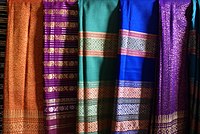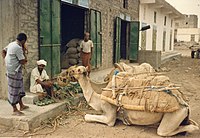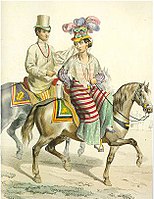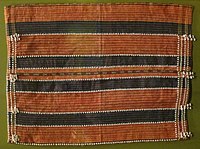Sarong
This article shouldspecify the languageof its non-English content, using{{lang}},{{transliteration}}for transliterated languages, and{{IPA}}for phonetic transcriptions, with an appropriateISO 639 code.Wikipedia'smultilingual support templatesmay also be used.(August 2021) |


Asarongor asarung(Malay pronunciation:[saˈroŋ],/səˈrɒŋ/) is a large tube or length offabric,often wrapped around the waist, worn inSoutheast Asia,South Asia,Western Asia,Northern Africa,East Africa,[1]West Africa,and on manyPacific islands.The fabric often employs wovenplaidor checkered patterns or may be brightly colored by means ofbatikorikatdyeing.Many modern sarongs haveprinteddesigns, often depictinganimalsorplants.Different types of sarongs are worn in different places in the world, notably thelungiin the Indian subcontinent and theizaarin the Arabian Peninsula.
The unisex sarong is typically longer than the men's lungi.
Etymology
[edit]The termsarongis an loanword fromMalaysarong(Jawi:ساروڠ,old spelling:سارڠ), meaning 'to cover' or 'to sheath'.[2][3]It was first used in 1834 referring to the skirt-like garment of theMalays.Sarongis also the informal spelling used in both colloquialIndonesianandMalaysianwhereassarung([ˈsaruŋ]) is the standard spelling.[4]
Sarongs are known as many different names across Asia, includingJavanesesarung(ꦱꦫꦸꦁ),Tamilsaram(சாரம்),Arabicṣārūn(صارون); andSinhalasarama(සරම).
In West Africa, the wordsrongorsorongis found in theAkanlanguage, and this word means "the highest point", in reference to the garment being fastened at the very top in order to secure it.[5]
Overview
[edit]-
Sarung denotes a length of fabric as agarment.
Sarongorsarungdenotes the lower garment worn bySoutheast Asianmen and women. This consists of a length of fabric about a yard (0.91 m) wide and two-and-a-half yards (2.3 m) long. In the center of this sheet, across the narrower width, a panel of contrasting color or pattern about one foot wide is woven or dyed into the fabric, which is known as thekepalaor "head" of the sarong. This sheet is stitched at the narrower edges to form a tube. One steps into this tube, brings the upper edge above the level of the navel (the hem should be level with the ankles), positions thekepalaat the center of the back, and folds in the excess fabric from both sides to the front center, where they overlap and secure the sarong by rolling the upper hem down over itself.Malaymen wear sarongs woven in a check pattern, while women wear sarongs dyed in thebatikmethod. However, inJavanese culture,the wearing ofbatiksarongs is common and not restricted to a particular gender; sometimes they are also worn on formal occasions such as weddings.
The sarong is common wear for women in formal settings with akebayablouse.Malaymen wear sarongs in public only when attending Friday prayers at themosque,[citation needed]but sarongs remain very common casual wear at home for men of all ethnicities and religions inBrunei,Indonesia,Philippines,Cambodia,Malaysia,Singapore,Sri Lanka,and much of theIndian subcontinent.[6](In the Indian subcontinent, excluding Sri Lanka, sarongs are sometimes known asmunduorlungi.)
Regional variations
[edit]Arabian Peninsula
[edit]-
Yemenimen in traditional sarongs
-
Yemeniman tying hisfutah(sarong). Sometimes people keep money or small utensils in the folds of the futah.
Sarongs known under a variety of local names are traditionally worn by the people ofYemenand elsewhere on theArabian Peninsula.Local names for the garment includeṣārūn,fūṭah,izaar,wizār,maqtabandmaʿwaz(pl.maʿāwiz). InHadhramout,Yemensarongs are calledSaroon(Arabic:صارونṣārūn) in the interior and the coastal region. InOman,sarongs are calledwizārand are often white in color, similar to theKeralanmunduof the Indian subcontinent and it is usually worn under theThawb.InSaudi Arabia,sarongs are known asizaar.Designs can be checkered or striped as well floral orarabesque,but double plaid (i.e., a vertical section of theizārwith a different plaid pattern) designs fromIndonesiaare also very popular. In southwestern Saudi Arabia, tribal groups have their own style of unstitchedizaar,which is locally woven. This is also worn in northern Yemen. However, the tribal groups in Yemen each have their own design for theirṣārūn,the latter of which may include tassels and fringes. It is thought that this tribalṣārūnresembles the originalizaaras worn on theArabian Peninsulasince pre-Islamic times such as theShendyt.They are generally worn open and unstitched in such a way that the garment does not reach over one's ankles. Otherizaars,often imported from Bangladesh, are the traditional clothing ofArabfishermen of thePersian Gulf,theIndian Oceanand theRed Sea.It was the traditional garment for men before the introduction of pant-like pajamas andkaftansduring the Turkish and European colonial periods. Tube-stitched, as well as open sarongs, are both worn, even informaldishdasha-wearing countries, as casual sleepwear and at home.
Indian subcontinent
[edit]
Sarongs, very similar to those of South-East Asia and completely different from the Indian subcontinent (excluding Sri Lanka) are widespread – in the state ofManipur,where they are calledphanekandmekhelainAssamwhich are very similar to traditional attire of other South-East Asian nations. In the SouthIndianstates ofKerala,they are calledmundu(if fully white or fully black) andlungiorkailiif coloured, and inTamil Nadu,they are calledkailiorsaaramorvettiorlungiand are usually worn at home. A standard lungi measures 2.12 by 1.2 metres.
Unlike the brightly colored Southeast Asian sarongs, the Kerala variety (themundu) is more often plain white and is worn for ceremonial or religious purposes. In Kerala, the brightly coloured sarongs are calledkailyand the white ones are calledmundu.The more formal, all-whitedhotiis worn for formal and religious occasions. While there are dresses based on themunduwhich can be worn by women, they more commonly wear thesari.
Sri Lanka
[edit]Sarongs are very common inSri Lankaand worn only by men. (A similar garment is worn by women. However, the women's garment is calledredda,which is a wrap-around skirt.) It is the standard garment for most men in rural and even some urban communities. However, most men of upper social classes (whose public attire is usually trousers) wear the sarong only for ceremonial purposes, as a convenient night garment or only within the confines of the house. The Tamil-speaking communities, theSri Lankan Tamilsand theSri Lankan Moorspeople also call itsaaramorchaaram.
Statistically, the number of people wearing sarong as their primary public attire is on the decline inSri Lanka,the reason being that the sarong carries the stigma of being the attire for less-educated lower social classes. However, there is a trend toward adopting the sarong as a fashionable garment or as a formal garment worn with national pride, only on special occasions.[7]Political and social leaders of Sri Lanka who want to portray their humility and closeness to the common person and their nationalism, choose a variation of the sarong nicknamed the "national" as their public attire.
Horn of Africa
[edit]Sarongs are ubiquitous inSomaliaand theMuslim-inhabited areas of theHorn of Africa.Althoughnomadicand urbanSomalimen have worn them for centuries in the form of a plain whiteskirt,the colorfulmacawiis(ma'awiis) sarong, which is the most popular form of the garment in the region. Before the 1940s, mostmacawiiswere made ofcotton.However, since the industrialization of the market, they now come in many fabrics and combinations thereof, includingpolyester,nylonandsilk.
Designs vary greatly and range from checkered square motifs with watermarked diamonds andplaidto simple geometric lines. The one constant is that they tend to be quite colorful; blackmacawiisare rare.Macawiisin Somalia are worn around the waist and folded several times over to secure their position. They are typically sold pre-sewn as one long circular stretch of cloth, though some vendors offer to sew them as avalue-addedservice.
Southeast Asia
[edit]Indonesia
[edit]

InIndonesiathe sarong is generally known as akain sarung('sarong cloth') except for inBaliwhere it carries the namekamben,possibly etymologically related tokemben(Javanese torso wrap). The sarung or sarong is often described as an Indonesian skirt; it is a large tube or length of fabric, often wrapped around the waist and worn by men and women throughout much of the Indonesian archipelago.[8]The sarong is also commonly described as a unisex tubular skirt.[9]
The most common design of the Indonesian sarong is woven cloth with checkered motifs, usually used byMuslim menforsalahprayer. This kind of sarong cloth is stitched together to create a tubular skirt-like lower garment. In Bali, sarongs are not stitched together as a tube, but remain as a piece of cloth to wrap around the waist and secured with a knot.
Other than common checkered motifs, other woven or print methods might be employed, such asbatik,ikat,songket,and other kinds oftenuntraditional woven clothes. Sarongs are used by variousethnic groups in Indonesia.They are made from a variety of materials such as cotton, polyester or silk.[8]Indonesian women wear traditional costumes calledkebayaas upper garments, while for lower garments they wear sarongs dyed in the batik method, with flower motifs and in brighter colors. However, in Javanese culture, the wearing of batik sarungs is not restricted to women on formal occasions such as weddings.
In 2019, in an effort to promote and popularize the sarong among its people, the government encouraged Indonesians to wear the sarong in public at least once a month. PresidentJoko Widodosaid the sarong is a significant element ofIndonesian cultureand that wearing it will be a sign of appreciation for sarong craftsmen.[9]
Malaysia
[edit]InMalaysia,the sarong is known as akain.The wordkainis paired with specific words to specify its type and function such askain pelikat(a type of sarong with a simple stripe and box pattern),kain sarung,[10]kain tenun(woven sarong),kain batik(sarong with batik motifs and design, normally worn by women and paired with akebayaorBaju Kurung) orkain sampingorsampin(specialized sarong worn by men withBaju Melayu). In the Malaysian state ofSarawak,it is calledsabok(for men) andtapeh(for women).
Since 2017, special celebrations aroundMalaysia Dayare held to encourage the wearing of sarong in public spaces as well as taking the railway system called theKeretapi Sarong('Sarong Train').[11]
Philippines
[edit]Sarongs from thePhilippinesare generally known astapisinLuzon,alampayin theCordilleranhighlands,patadyongin the islands ofVisayasandSulu,andmalonginMindanao.They are worn by both men and women and can be rectangular or tube-like. They can be knee-length or ankle-length and come in various colors that are usually unique to the specific ethnic group that wove them. Among men, the skirt is usually drawn up and tied at the waist (like adhoti), forming a trouser-like clothing known as asalawal.They can also serve as shawls or blankets. They were paired with close-fitting shirts or jackets known asbaroorbayu.[12][13][14][15][16]
Among theMaranao people,themalongis featured in the folk dancekapa malong malongwhich shows the various ways that themalongcan be utilized.[17]
During theSpanish colonial era,thetapiswas worn over a longer skirt (sayaorfalda) due to the shortness of thetapisbeing deemed too immodest by the Spanish clergy to be worn alone. It evolved over time to become part of the traditional Filipino dress for women, thebaro't saya.[14][18]
-
Apatadyongfrom theSulu Archipelagoin theHonolulu Museum of Art
-
Cordilleranalampayin theHonolulu Museum of Art
Western world
[edit]
In North and South America as well as Europe, hip wraps are worn as beach wear or as a cover-up overswimwear.The wrap is often made of a thin, light fabric, oftenrayon,and may feature decorative fringing on both sides. They may have ties, which are long thin straps of fabric which the wearer can tie together to prevent the wrap from falling down. These wraps are mostly worn by women as beach cover-ups and do not usually resemble traditional Asian or African sarongs in size, pattern or design. Western men who wear male sarongs are influenced by the Scottish kilt orlavalavawithin the Polynesian or Samoan culture. Typically sarongs are worn by men when they are at home, the beach, by the pool, or on a cruise.[19]
Securing
[edit]Numerous tying methods exist to hold a sarong to the wearer's body. In some cases, these techniques customarily differ according to the sex of wearer. If a sarong has ties, they may be used to hold it in place. Sarong ties give the wearer a little extra hold and security.[20]If no ties exist, a pin may be used, the fabric may be tightly tucked under itself in layers, the corners of the main sheet may be wrapped around the body and knotted, or abeltmay be used to hold the sarong in place.
Similar garments
[edit]The basic garment known in English most often as asarong,sewn or unsewn, has analogs in many regions, where it shows variations in style and is known by different names.
- Africa
- InEast Africa,it is called either akanga(worn by African women), or akikoy,traditionally worn by men and used with much simpler designs, however, it is used more frequently in high fashion.Kangasare brightly coloured lengths ofcottonthat incorporate elaborate and artistic designs and usually include the printing of a Swahili proverb along the hem.
- InMadagascarit is called alamba.
- InMalawiit is called achitenje.
- InSomaliait is called amacawisorhoosgunti.
- InMauritiusit is called apareo.
- InMozambiqueit is called acapulana.
- InSouth Africait is called akikoiand commonly used as a furniture throw or for going to the beach.
- InZambiathey are known aschitenge.
- Brazil
- Middle East
- InSaudi Arabia,it is calledfouta(Arabic:فوطه).
- InYemen,it is called eitherfouta(Arabic:فوطه) ormeouaz(Arabic:معوز).
- Indian subcontinent
- InSouth Indiait is called alungi.It is most often sewn into a large cylindrical shape, so there is no slit when thephanekorlungiis tied.
- In eastern India andBangladeshit is known as alungi.
- InNortheastern Indiatraditional clothing are thephanekin Manipur andmekhelain Assam which are very similar to the traditional attire of other South-East Asian nations.
- In South India it is calledveettiinTamil,panchainTelugu,pancheinKannada,andmunduinMalayalam.
- In the southernmost districts of Tamil Nadu, it is also known aschaaram,possibly influenced from Sri Lanka from the trading days.
- In theMaldives,and Indian state ofKerala,it is known as amundu,feyli[21]orneriyathu.
- InPunjabit is a calledchadra.
- InSri Lankait is calledsaramin Tamil, andsaramainSinhalese.
- Southeast Asia
- InCambodiaសារុង /saaroŋ/[22]is used as an alternative toសំពត់ /sɑmpʊət/.[23]
- InIndonesia,it is generally known assarungorkain sarung,but in larger extent inIndonesian languagesit can be known ascawat,cindai,tapih,tapis,lunggi,lurik,pareo,palepai,jarit,jarik,sinjang,kampuh,poleng,sindai,selongsong,wiru,andwiron.
- InLaosandIsan(northwestern Thailand), it is called asinh(Lao:ສິ້ນ,Thai:ซิ่น), as well assarong.
- In Malaysia it is known as akain,kain pelikat,kain sarung,kain tenun,kain batik,orkain sampin(specialised sarong worn by men withBaju Melayu). In the Malaysian state of Sarawak, it is calledsabok(for men) andtapeh(for women).
- InMyanmar,it is known as alongyi.
- In thePhilippinesit is generally known asmalong(inMindanao),patadyong(inVisayasand theSulu Archipelago), andtapis(inLuzon). It can function as a skirt for both men and women, aturban,niqab,hijab,a dress, a blanket, a sunshade, a bedsheet, a "dressing room", a hammock, a prayer mat, and other purposes. During the Spanish colonial period, it evolved into a distinctive outer covering of the skirt for thebaro't saya.[24]
- InThailand,it is known as apha khao ma(Thai:ผ้าขาวม้า) for men and apha thung(Thai:ผ้าถุง) for women.
- Pacific Islands
- InNew Zealand,Māori know it as a Rāpaki
- InFijiit is known as anisulu.
- InHawaiiit is referred to askikepa.
- InPapua New GuineatheTok Pisinterm islap-lapand it is worn by men and women. In the other lingua franca,Hiri Motu,it is calledrami.
- InRotuma,it is known as ahạ' fạli.
- InSamoait is known as alavalava(alsolava-lava).
- InTahitiandCook Islandsit is known as apāreu.
- InTongait is known astupenu.
- InWallis and Futunait is known askie.
-
A traditionalKhmer dancerwearing a sampot inCambodia
-
A group of local women wearing sarong andkebayaat the entrance of traditional house in a village atMinahasa,North Sulawesi,Indonesiac.1900
-
PolynesianHiva Oadancers dressed in pāreu around 1909
In the media
[edit]The American public is most familiar with the sarong for the dozens offilmsset in the South Seas, most of them romantic dramas made in the 1930s and 1940s.Dorothy Lamouris by far the actress most linked with the garment, which was designed byEdith Head.[citation needed]Lamour starred in multiple films of this genre, starting withThe Hurricanein 1937. In fact, Lamour was nicknamed "The Sarong Girl" by the press and even wore a sarong on occasion in more traditional films.[citation needed]Among the other actresses to don the sarong for film roles areMaria Montez,Gilda Gray,Myrna Loy,Gene Tierney,Frances FarmerandMovita.Male stars who wore the manly sarongs on film includeJon Hall,Ray Milland,Tyrone Power,Robert PrestonandSabu Dastagir,as well asRalph FiennesinThe Constant Gardenerand Pierce Brosnan inThe Thomas Crown Affair.
The 2005 documentary filmSoldiers in Sarong,directed by Lokendra Arambam, depicts the women's resistance movement inManipur, North-East India.[26]The 2020 Indonesian filmTarung Sarungdepicts a martial arts tradition where combatants are joined together by the garment.
In Singapore, the termSarong Party Girlrefers to a local single Singaporean woman especially of Chinese ethnicity who favor socializing and having relationships with expatriate Caucasian men rather than the local ones.
See also
[edit]References
[edit]- ^"Selyn - Fair Trade Handlooms".Selyn - Fair Trade Handlooms.Archived fromthe originalon 26 February 2017.Retrieved28 March2018.
- ^Wilkinson, Richard James(1932)."sarong".A Malay-English dictionary (romanised).Vol. II. Mytilene: Salavopoulos & Kinderlis. p. 390.
- ^"Sarong".Online Etymology Dictionary, Douglas Harper. 2020.Retrieved21 November2020.
- ^Compare sources in:
- ^Christaller, Johann Gottlieb (June 22, 1881)."A Dictionary of the Asante and Fante Language Called Tshi (Chwee, Tw̌i): With a Grammatical Introduction and Appendices on the Geography of the Gold Coast and Other Subjects".Evangelical Missionary Society – via Google Books.
- ^"Singh, Atom Sunil;" Indigenous Games between Cambodia and Manipur: A Borderless Connectivity "".E-pao.net.Retrieved2011-09-18.
- ^"Travelsrilanka - Seven Additional Uses for a Sarong - Sri Lanka".travelsrilanka.Archived fromthe originalon October 7, 2007.
- ^abGultom, Obbie Afri (2014-04-26)."Indonesian Skirt: The Famous Indonesian Sarong".Eat,Travel and Style.Retrieved2020-10-29.
- ^ab"Jokowi Wants Indonesians to Wear Sarong at Least Once a Month".Jakarta Globe.5 March 2019.Retrieved2020-10-29.
- ^Mohamad, Maznah (28 March 1996).The Malay Handloom Weavers: A Study of the Rise and Decline of Traditional Manufacture.Institute of Southeast Asian Studies.ISBN9789813016996.Retrieved28 March2018– via Google Books.
- ^"Organiser ready to cooperate with KKD to make 'Keretapi Sarong' part of National Month activity".BERNAMA.17 September 2023.
- ^So, Michelle P. (17 April 20080."Caught in the Net: 'Tapis' cops"(editorial column) (ArchivedApril 20, 2008, at theWayback Machine).Sun Star Cebu.
- ^"The Filipiniana Dress: The Rebirth of the Terno".Vinta Gallery.Retrieved19 February2020.
- ^abcCoo, Stéphanie Marie R. (2014).Clothing and the colonial culture of appearances in nineteenth century Spanish Philippines (1820-1896)(PhD). Université Nice Sophia Antipolis.
- ^Perdon, Renato (22 August 2013)."Muslim Filipinos: An Ethnic Ensemble".Munting Nayon.Retrieved20 February2020.
- ^Lorna Kaino (1995).The Necessity of Craft: Development and Women's Craft Practices in the Asian-Pacific Region.University of Western Australia Press. p. 52.ISBN978-1-875560-62-2.
- ^"Kapa Malong-Malong".DanceAndDance.Retrieved14 July2020.
- ^abScott, William Henry(1994).Barangay: Sixteenth Century Philippine Culture and Society.Quezon City: Ateneo de Manila University Press.ISBN971-550-135-4.
- ^"men".Sarong Blog.2014-04-03.Retrieved2016-09-21.[permanent dead link]
- ^"Sarongs: A Journey Through Style and Function".15 July 2023.
- ^Sarong,The British Museum
- ^"SEAlang Dictionary".sealang.net.Retrieved2023-10-15.
- ^"SEAlang Dictionary".sealang.net.Retrieved2023-10-15.
- ^"Tapis".Philippine Folklife Museum Foundation.Retrieved19 February2020.
- ^"Baro't Saya".Philippine Folklife Museum Foundation.Retrieved19 February2020.
- ^"Soldiers in Sarong directed by Lokendra Arambam".Cultureunplugged.Retrieved2011-09-18.
External links
[edit] The dictionary definition ofsarongat Wiktionary
The dictionary definition ofsarongat Wiktionary













![The tapis of the traditional colonial Filipino baro't saya dress, evolved from a sarong-like wrap with the addition of a long skirt (saya) underneath, due to Spanish demands for modesty[14][25][18]](https://upload.wikimedia.org/wikipedia/commons/thumb/5/53/Fabi%C3%A1n_de_la_Rosa_-_Filipina.jpg/123px-Fabi%C3%A1n_de_la_Rosa_-_Filipina.jpg)

